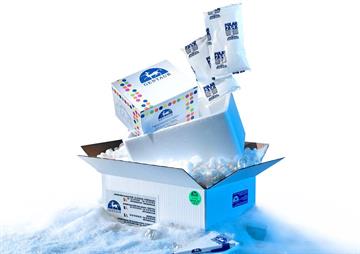Anti-Human DAN Antibody

Anti-Human DAN Antibody
748.5 EUR
In Stock
quantity
Produktdetaljer
Katalognummer: 209 - 101-M374
Produktkategori: Företag och industri > Vetenskap och laboratorium
ReliaTechGentaur
Storlek: 100 µg
Related Products
101-M374
Anti-Human DAN Antibody
DAN (differential screening-selected gene aberrative in neuroblastoma) was initially identified as a gene whose expression is downregulated in src-transformed rat fibroblasts. Human DAN was isolated from a normal lung cDNA library using mouse DAN as a probe. DAN has now been shown to be a prototypical member of the DAN family of secreted glycoproteins that are putative antagonists for TGFβ superfamily proteins. DAN family members share a cysteine-rich domain that is structurally related to the cysteine-knot motif found in TGFβ superfamily ligands. There are at least five mammalian DAN family members including DAN, Gremlin/DRM, Cer1 (Cerberusrelated), Dante and PRDC (protein related to DAN and cereberus). Additional DAN family members include Xenopus Cerberus, chick Caronte and C. elegans CeCan 1. The DAN family of proteins are thought to act as antagonists by binding TGFβ family ligands and preventing their interactions with signaling receptor complexes. Recombinant human DAN preparationss have been shown to bind BMP4 in a functional ELISA and to inhibit BMP4 mediated bioactivity in ATDC 5 chrondrogenic cells. It is likely the various DAN family members and other TGFβ BMP antagonists including Noggin, Chordin, Follistatin and TSG can selectively antagonize the activities of different subsets of TGFβ superfamily ligands. These antagonists represent one of the many elaborate regulatory mechanisms that have evolved to control the bioactivities of the TGFβ superfamily ligands.
748.5 €
102-P104
Anti-Human CRP Antibody
C-Reactive Protein (CRP) is a member of the Pentraxin family of proteins that are characterized by a cyclic, non-covalent, pentameric structure. IL-6, IL-1 beta, and glucocorticoids induce hepatic C-Reactive Protein synthesis and release. In humans, C-Reactive Protein is a major acute phase protein, increasing by 1,000-fold within 24 to 48 hours of infection, inflammation or tissue damage. C-Reactive Protein exhibits calcium-dependent binding of its principle ligand, phosphocholine, a constituent of bacterial and fungal cell walls. Upon ligand binding, C-Reactive Protein initiates the activation of the complement cascade and binds Fc gamma RI (CD64) and Fc gamma RIIA (CD32a) on phagocytes to activate phagocytic responses. In mouse, C-Reactive Protein is expressed at very low levels and is not an acute phase reactant.
518.55 €
102-P200
Anti-Human OPG Antibody
Osteoprotegerin (OPG) is a member of the TNFR superfamily that can act as a decoy receptor for RANKL. Binding of soluble OPG to sRANKL inhibits osteoclastogenesis by interrupting the signaling between stromal cells and osteoclastic progenitor cells, thereby leading to excess accumulation of bone and cartilage. OPG is expressed in a wide variety of tissues including adult heart, lung, kidney, liver, spleen, prostate, lymph node and bone marrow. OPG is secreted both as a monomeric and a dimeric protein. Its primary structure consists of seven distinct domains, four of which corresponds to the extracellular cysteine-rich domains of TNFR proteins and constitutes the soluble OPG. Recombinant human OPG is a soluble 20.0 kDa protein containing 174 amino acid residues.
518.55 €
102-P239
Anti-Human MIA Antibody
MIA is the first discovered member of a family of secreted cytokines termed the MIA/OTOR family. The four known members of this family; MIA, MIA2, OTOR and TANGO each contain a Src homology-3 (SH3)-like domain. MIA is an autocrine growth regulatory protein secreted from chondrocytes and malignant melanoma cells that promotes melanoma metastasis by binding competitively to fibronectin and laminin in a manner that results in melanoma cell detachment from the extracellular matrix in vivo. Elevated levels of MIA may represent a clinically useful marker for diagnosis of melanoma metastasis as well as a potential marker for rheumatoid arthritis. Recombinant human MIA is a 12.2 kDa globular protein containing 108 amino acid residues including two intramolecular disulfide bonds. .
518.55 €
Håll dig uppdaterad! Visa tidigare publikationer

By: Author , 2 Comment
Anaplasmos hos hundar och katter – allt du behöver veta
23 August 2025

By: Author , 2 Comment
Solbränna – hur leker man säkert i solen?
16 August 2025

By: Author , 2 Comment
Biologiska läkemedel – Modernitet inom farmaci
1 August 2025

By: Author , 2 Comment
Icke-steroida antiinflammatoriska läkemedel – viktig information om populära läkemedel
22 July 2025








